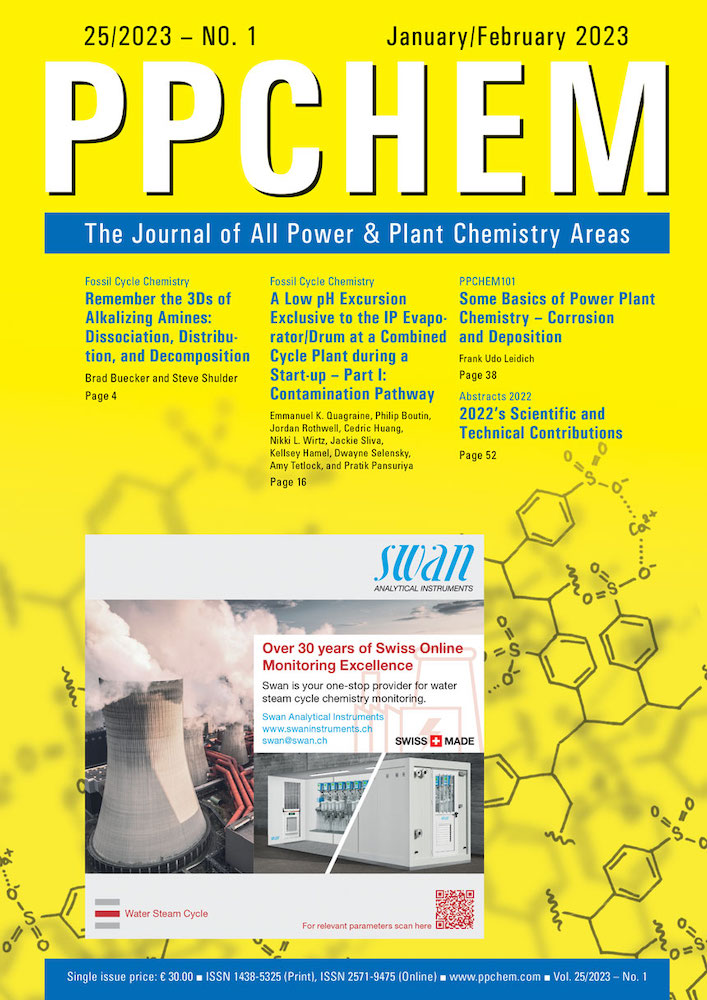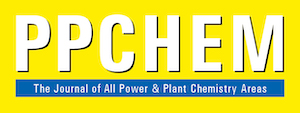Author: anderthalbAdmin
Article – Issue 02 (2023) – A Low pH Excursion Exclusively in the IP Evaporator/Drum at a Combined Cycle Plant during a Start-up – Part II: Lessons Learned
Article – Issue 02 (2023) – Connecting the Dots between Steam Generator Chemistry and Fundamental Thermodynamics
E-Paper – Issue 02 (2023)
All Articles from 2016
Issue 01 (2023)

For members only
ABSTRACTS
Remember the 3Ds of Alkalizing Amines: Dissociation, Distribution, and Decomposition
Brad Buecker and Steve Shulder
Carbon steel corrosion control of condensate lines, feedwater piping, and boiler internals is critically important in all steam generation applications. A key corrosion control aspect is establishing and maintaining a mildly alkaline pH throughout these networks. Organicbased alkalizing amines have a place in lower- and intermediate-pressure boilers, industrial plant condensate-return systems, and nuclear power plant secondary cycles. However, careful evaluation and research is needed when selecting a program. This article examines the “3Ds” of alkalizing amines, dissociation, distribution, and decomposition, and how these properties influence the selection of the compounds for controlling condensate and feedwater chemistry. Dissociation and distribution are equilibrium or reversible reactions while decomposition is irreversible. The article examines these properties for high-pressure utility units and offers some comparisons/contrasts for lower-pressure industrial systems, which often have extensive steam and condensate-return networks.
PPCHEM® 2023, 25(1), 4–13
For Members only
A Low pH Excursion Exclusive to the IP Evaporator/Drum at a Combined Cycle Plant during a Start-up – Part I: Contamination Pathway
Emmanuel K. Quagraine, Philip Boutin, Jordan Rothwell, Cedric Huang, Nikki L. Wirtz, Jackie Sliva, Kellsey Hamel, Dwayne Selensky, Amy Tetlock, and Pratik Pansuriya
This is the first of a two-part article on the investigation of a low pH excursion which occurred exclusively in the intermediate-pressure (IP) evaporator/drum of a combined cycle plant at a start-up. The selective contamination occurred as glycol from closed-circuit cooling water (CCCW). The proposed contamination route is via a boiler feed pump (BFP), specifically O-ring seals separating the CCCW from the feedwater. The estimated leak rate is 8.0–22.9 mL ⋅ h–1, which is sufficient to cause the pH excursion. At start-up, the BFP would have charged the IP (and not the high-pressure (HP)) circuit line with water whilst in recirculation mode; this was later used to fill the IP drum. The HP drum was filled an hour later. Thus, accumulated glycol that leaked into the pump casing would have been pumped more exclusively into the IP circuit, resulting in the selective contamination. Through recirculation, glycol that potentially entered the low-pressure circuit, eventually feeding the HP circuit, would have been sufficiently diluted to prevent such an excursion in these two corresponding evaporators/drums.
PPCHEM® 2023, 25(1), 16–34
For Members only
Some Basics of Power Plant Chemistry – Corrosion and Deposition
Frank Udo Leidich
Undesired corrosion and deposition reduce the lifetime of a power plant or its specific components. Even before a component in the water/steam cycle (WSC) is damaged or destroyed, economic damage has already been caused in terms of a reduction in efficiency, deterioration in availability, and increased maintenance and repair costs. In order to limit corrosion and deposition to acceptable levels, monitoring and control of the physico-chemical parameters of the working media is necessary. It is also necessary to purify (treat) the working medium (water/steam) and add chemicals suitable for reducing corrosion reactions and deposit formation on the components and parts of the WSC. This paper gives an overview of the different types of corrosion, where they occur in the WSC, and the potential hazards they pose. The most widespread deposits, their composition, impact, and origin are also discussed.
PPCHEM® 2023, 25(1), 38–50
For Members only
2022’s Scientific and Technical Contributions
PPCHEM® 2023, 25(1), 52–59

